I was a frustrated teenage photographer, unable to afford the cameras that I saw in the window of Jessops in Belfast and in the pages of Amateur Photographer that I browsed – and occasionally bought – in the newsagents. This was the era of classic enthusiast film cameras – the Olympus OM system, the Pentax MX and ME, the Canon A series, the Minolta XD’s and my personal favourites, the Nikon FM and FE. Time passed and my enthusiasm passed with it, only rekindled much later in the era of the plastic, auto- everything camera.
Last year, though, I finally realised my teenage dream and acquired a very nice Nikon FM2n, rapidly followed by an equally nice F3 and a set of Nikkor primes. Tempted as I was to keep adding SLR’s (the OM-4 and XD-7 were particularly appealing) I decided that the next step was to add a smaller camera for those times when I wanted to carry something more discreet. This is when I discovered the world of compact rangefinders.
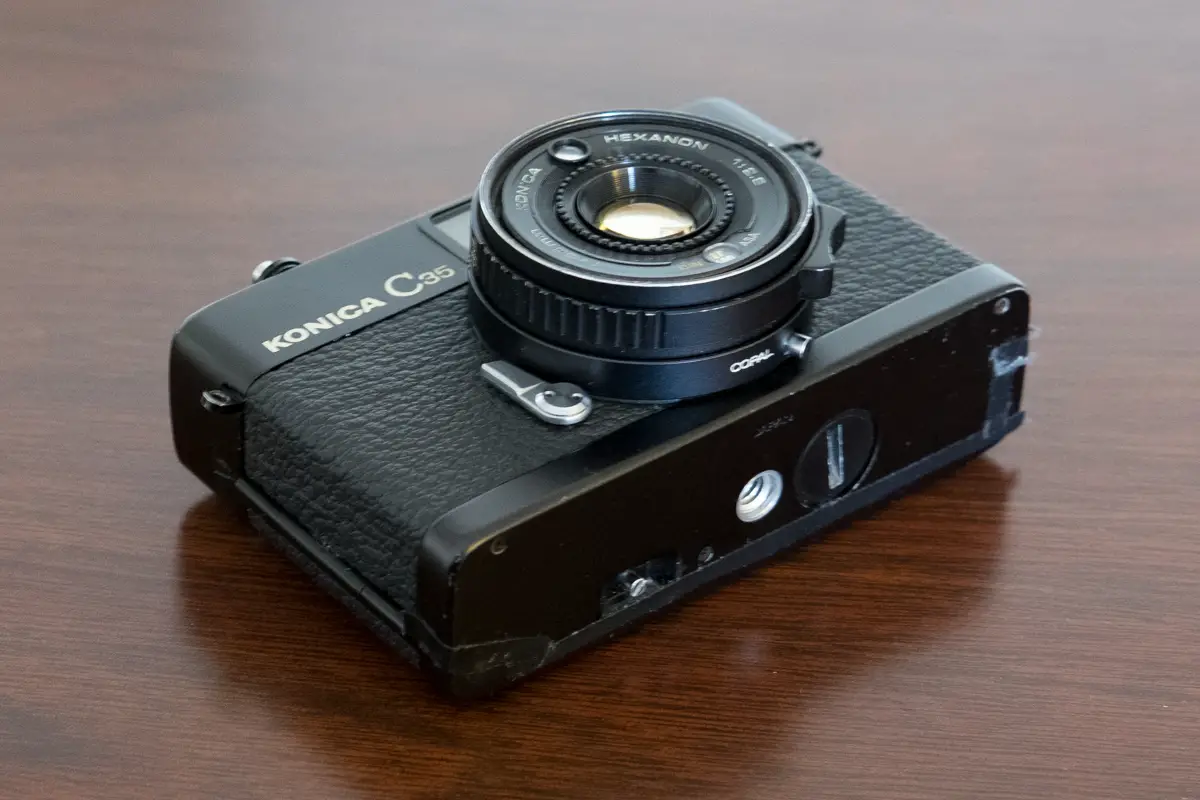
Strangely, even though many of these little cameras were still in production at that time I was considering those classic SLR’s, I have no recollection of them. Even stranger considering that when I did eventually buy a camera back then it was a rangefinder, specifically a Zorki 4K, though I bought it, not so much because it was a rangefinder, but because it was cheap – around 30 quid I believe.
Thankfully, when I began my recent researches, I no longer had to peruse Amateur Photographer to gain my delayed education in compact rangefinders and I surfed widely and consumed deeply while considering my options. Enthusiasts sang the praises of their preferred cameras, but my impression, after reading through more online reviews than I could count, was that there was little to choose between many of them, not only in terms of features but also in terms of the number of failings they were subject to.
Foggy viewfinders, perished seals, corroded electrics, stick or oily shutter or aperture blades, fungus in the lenses, mercury batteries – amazing how much can go wrong with these little cameras considering how simple they are. Or, perhaps its more amazing that after nearly fifty years some are still working, or fixable, given that these were very much consumer grade products.
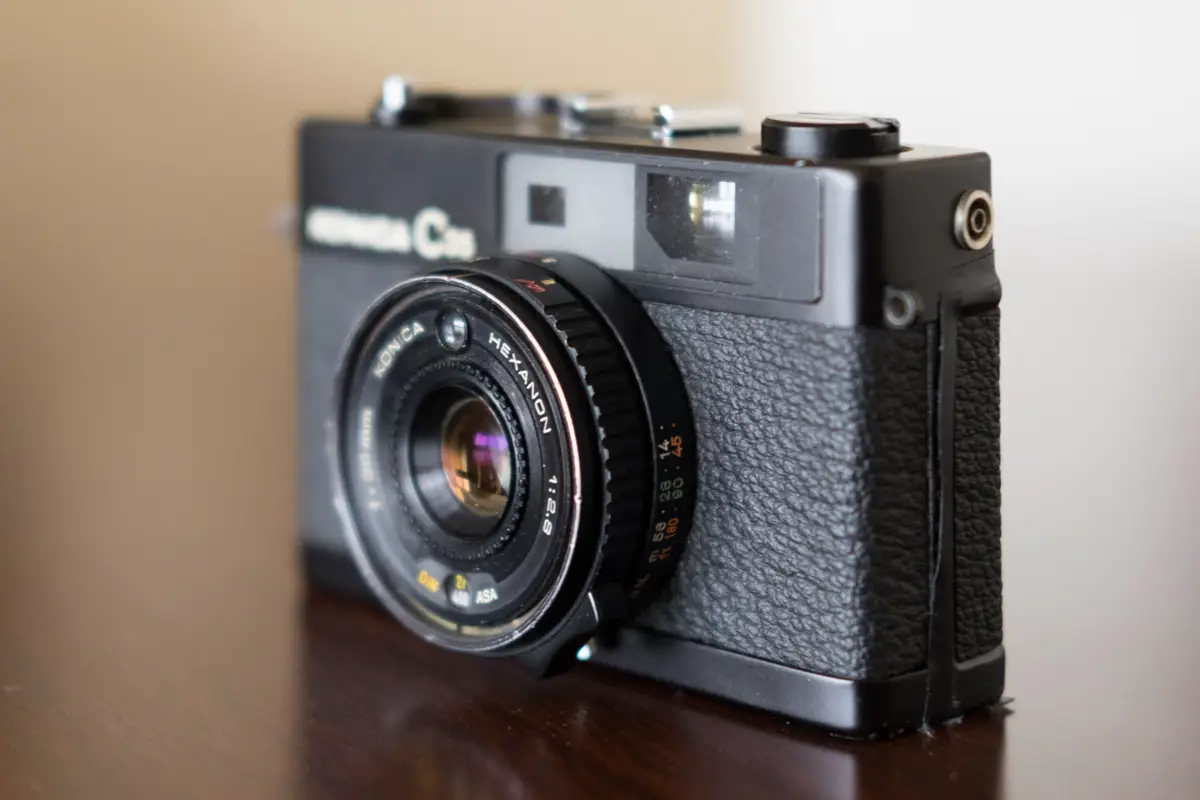
Since no one camera appealed to me more strongly than the rest I turned to a more subjective criterion finding myself drawn to those camera makers who are sadly no longer with us – or no longer making cameras – which put Konica, Minolta and Yashica high on my list. Ultimately, though, the two most important criteria for me were that, whatever the maker, the camera needed to work, and it had to be reasonably priced.
So should I spend more and buy a serviced camera from a specialist? Or go cheap and hope for the best? The former appealed to my cautious nature but rather defeated the point of having a cheap and cheerful alternative to my SLR’s. The latter ran the risk of ending up with a novelty paperweight.
Finding a Konica C35
Thankfully my indecisiveness and procrastination paid off since I was still considering my options when Used Photo Pro posted a Konica C35 for sale on their site. Advertised as being in working order, and with a 14 day return period and a six month guarantee, it was an easy decision. A few days later it was mine, for $30.
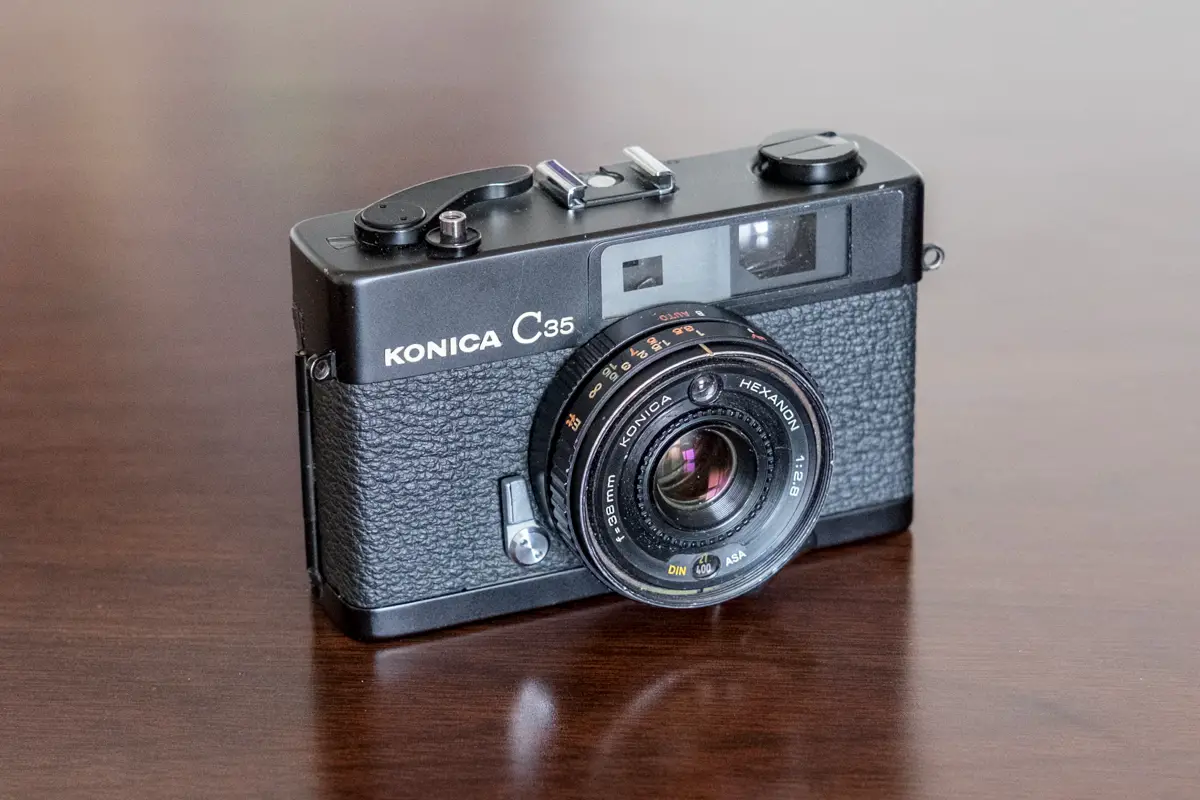
First impressions
My Konica C35 is black which looks good, better than the chrome version. It’s definitely compact, but it’s also beautifully simple. Thus while it is compact it still handles comfortably being free of the buttons, knobs, dials and blinking lights that festoon similarly sized digital cameras. That it has to be of a certain thickness to accommodate a film canister also contributes to this comfortable feel. In fact, it’s not dissimilar in size to my Fuji X-E2 which, no doubt, is why it feels good in my hand. It’s solid and has some weight to it even though it is only a ‘point and (focus and) shoot’ camera.
Second impressions
The film door has a little bit of play in it, possibly because the light seals are somewhere between lousy and non-existent. While having no interest in getting sucked into camera repair, this is one task I feel I can manage, courtesy of the many instructional posts and videos online. The viewfinder looks clear enough to me without any fogging, though there are a lot of little dust specks inside. There is also something – dirt or mould – on the exposure scale but it remains usable apart from the f5.6 mark where one blob obscures the needle. The perfectionist in me would really like to clean it but I’m not convinced about trying to do it myself, and getting someone else to do it would undoubtedly cost much more than I paid for the camera so I’ll probably just learn to live with it as long as it doesn’t get any worse. Overall, though, it’s surprisingly clean and free of signs of wear and tear. I like to think that’s because it has been well cared for and lightly used.
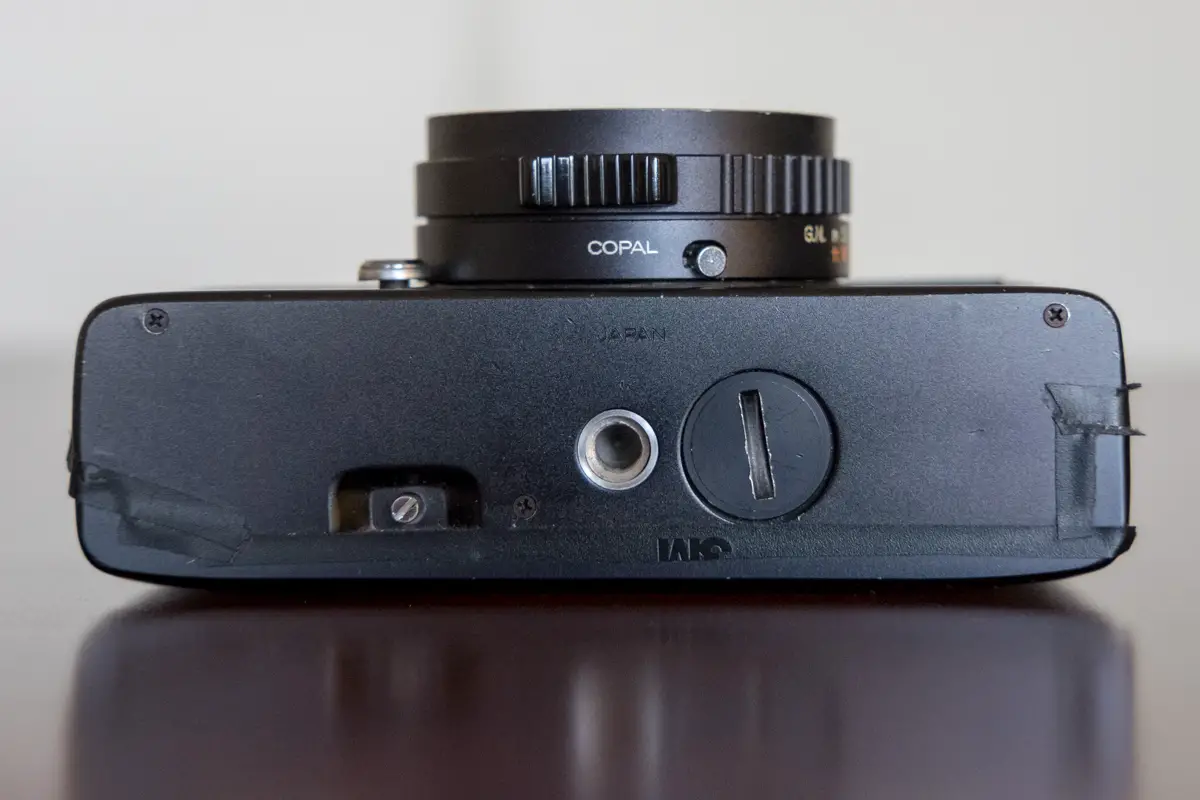
As part of my research I had downloaded and read manuals for all of the cameras I was interested in, including three versions of the Konica C35 manual. (And a word of thanks to all those good people who scan and post these manuals online.) In anticipation of the camera’s arrival I had ordered a lens cap, use of which appeared to be the only way to switch off the meter. I had also ordered a Weincell MRB675 in place of the no longer available PX675 mercury battery. I did this despite having a handful of SR44 cells lying around because I had read that using the latter, slightly more powerful, battery would affect the accuracy of the metering leading to underexposure. So when the camera arrived I was all ready to go.
It didn’t work
The exposure indicator needle twitched, but refused to leave the under-exposure red zone no matter how bright the scene I pointed the camera at. I checked the battery – had its thirty minute warm up, in the right way round, battery cap properly closed. No lens cap accidentally left on. It still didn’t work. The shutter also seemed to have a problem. While it snapped open it seemed a little too leisurely while closing again.
I was all set to pack it up and send it back when on a whim I replaced the MRB675 battery with an SR44. The needle zipped up and down the exposure scale. So it seemed the new battery was the problem. That just left the sticky shutter but five minutes winding and firing over and over again seemed to resolve that issue.
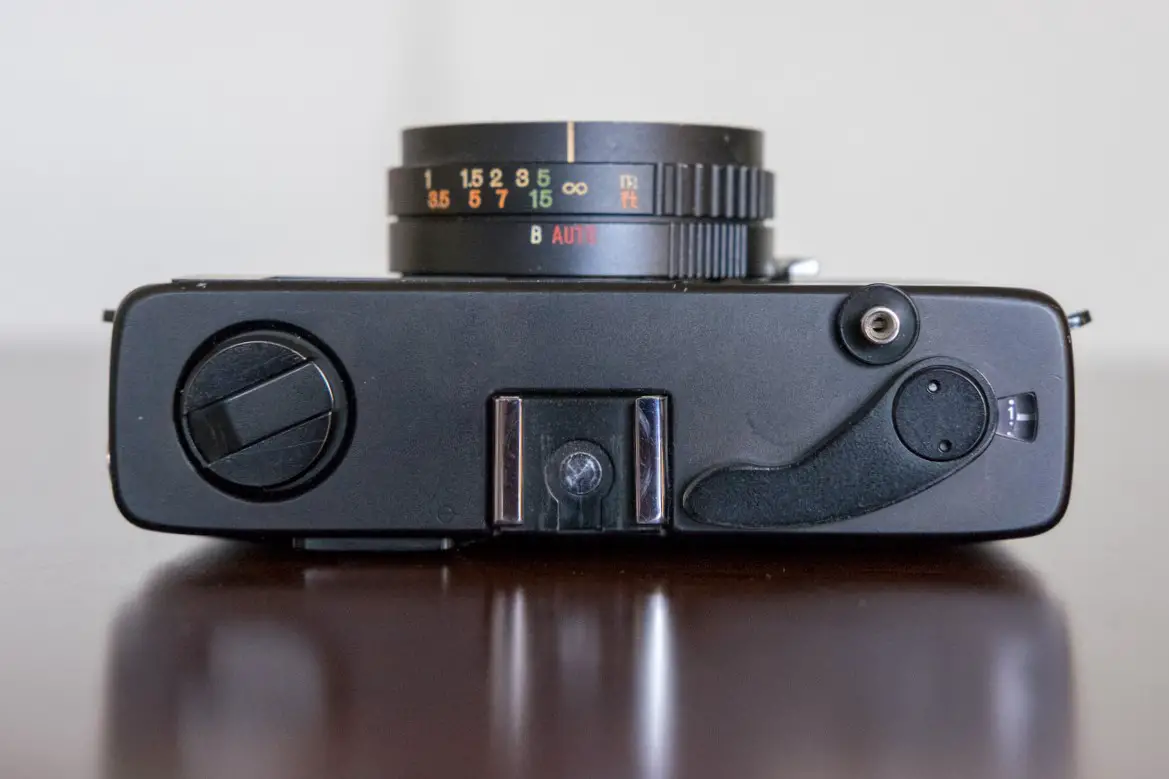
Setting the light meter
Now the challenge was to work out how the more powerful battery was affecting the exposure metering. I set the Konica C35 to 200 ASA and pointed it a blank white laptop screen so that the screen filled the bright frame in the viewfinder. Just under f4; just under 1/125. For comparison I used my Fuji X-E2. The Konica’s metering is centre-weighted, an option that isn’t available on the Fuji so I set it to average on the basis that it should make no difference when metering on a blank white screen. With the lens at f4 I framed the screen with the Fuji and checked the shutter speed – 1/85. About half a stop under exposed then. Much better than the two stop difference which I had read of in a number of posts.
On the basis that a bit of overexposure is better than a bit of underexposure the simplest way to adjust this on the Konica C35 is to set the ASA one stop under box speed: if it’s a 400 film set it to 200, if it’s 200 set it to 100, if it’s 100 set it to 50. The ASA dial moves in 1/3 stop increments, so you can fine tune the exposure adjustment to some extent.
So I was all set to go for the next day. Load up some film, tape up the film door to compensate for the banjaxed seals, and hit the streets – and museums and memorials – of Washington DC.
But first, a quick run through on the controls
Up top there’s a film wind lever and frame counter, a threaded shutter release, an accessory shoe for a flash, and a combined film rewind crank and door release. On the left hand side is a PC socket. On the front is a self timer lever. On the base is a film rewind release button, a tripod socket and a battery chamber. On the barrel of the lens is the shooting mode ring with release button and the focus ring with a focusing knob. On the front of the lens is the film speed ring and the CdS cell for metering. The lens itself is a Hexanon 38mm f2.8 with four elements in three groups.
There are three shooting modes: auto, B and flash. I rarely use flash and I can’t imagine any circumstances in which I would do so on this camera so I’ve no idea how this works. When selecting B the metering disengages and the aperture defaults to 2.8. Again, I can’t think when I would ever use this setting. For me, this is a camera to set on auto and leave there.
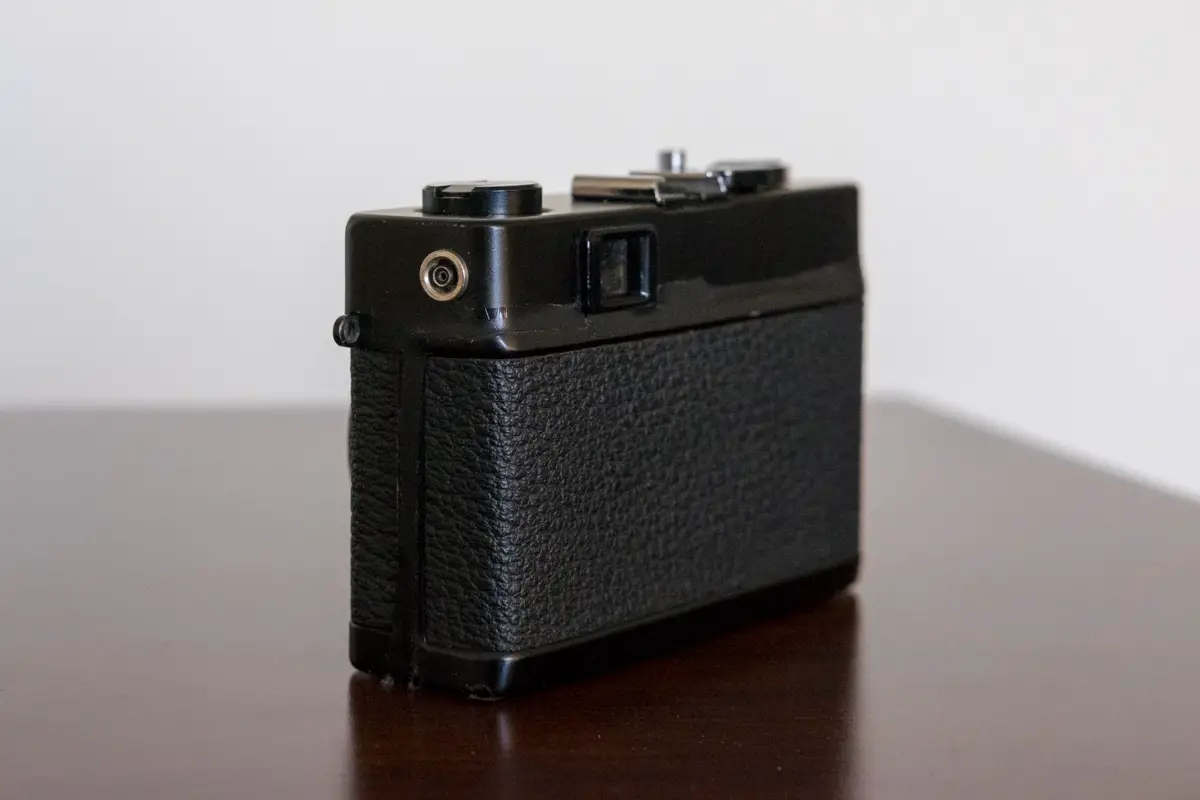
The Konica C35 focus ring has a throw of around 60o and moves smoothly and evenly. Closest focus is 3.5 feet. The ASA ring is a knurled dial on the front of the lens which you push in and turn until the required ASA number appears in the small window directly below the front element. ASA range is from 25 to 400.
Looking through the Konica c35 viewfinder, on the right side is the exposure indicator. A vertical scale lists shutter speed and aperture combinations from 30/2.8 through to the slightly unusual 650/14. The camera selects one of these combinations but there is no way to adjust them. To put it another way, you get programme mode, but not programme shift. A swinging needle indicates the chosen combination. You can lock the exposure with a half press on the shutter release so it is possible to meter and recompose. This and the ASA speed adjustment are the only options for fine tuning the exposure in Auto mode. There are red zones top and bottom to indicate over- and under-exposure. There is no shutter lock, so the shutter will still fire if the needle is in either zone.
The Konica C35 shutter and aperture are both controlled by a single set of blades in the lens. The shutter is mechanical so I assume that it only operates at fixed speeds. Since the shutter speed numbers and the aperture numbers aren’t precisely aligned on the viewfinder scale and since the needle can and does stop between numbers, it’s difficult at times to know precisely what combination has been selected.
The viewfinder also displays the focusing screen, a bright line frame and a parallax compensation mark for composing at distances of less than four feet. Both marks are still very clear and easy to see. A flash symbol appears when the flash mode is selected.
Operation of the camera couldn’t be simpler. Set the mode ring to Auto, compose, focus, shoot, wind – repeat 36 times. Rewind.
Time to take some pictures
A cheap roll of Kodak Gold 200 is the film choice and thin strips of black electrical tape seal it in. The Konica C35 is pocketable if you are wearing a coat. I was, so I didn’t bother with a bag and just kept it handy in a front pocket. I took a walk round downtown DC, the Mall and the Air and Space Museum the first day, and visited a couple of the DC Monuments the second day. I took some shots at ASA 200 and others at ASA 100 to see what difference it made. I took some shots in a darker part of the museum when the needle was only just clearing the red zone. On an overcast day it never got particularly bright but I covered a reasonable range of lighting conditions.
The simplicity of the Konica C35 makes it a joy to use. The only problem I encountered is that I sometimes had to readjust my eye to see clearly through the relatively small viewfinder window on the back. The needle can also be a little difficult to see in darker environments. Other than that everything works. The film advance lever has a reasonably short throw and moves smoothly, the same is true of the focusing ring. The shutter button requires quite a long press before the shutter fires with a discernible click, but, again, it moves smoothly. The leatherette finish enables easy handling free of the fear of the camera slipping from your grasp (something I’ve learned to appreciate as a former owner of a Sony RX100).
My first roll complete I stripped off the black tape and took the film to District Photo in downtown Washington for developing, taking care to explain the circumstances in the hope that they wouldn’t then conclude that I was the world’s least competent photographer.
Two days to wait
In the meantime I opened the back and did some more testing of the meter and shutter. Worryingly, I had the distinct impression that the shutter had started sticking again when closing. Did this mean that every shot I had taken was going to be drastically over-exposed? I wound and fired, wound and fired, wound and fired, and again the blades eventually started to snap shut. This time I kept going. Later that day I did the same again. I kept at it. The following morning the shutter still seemed to be working properly. While repeated usage may be enough to loosen it up permanently perhaps I also need to clean the blades.
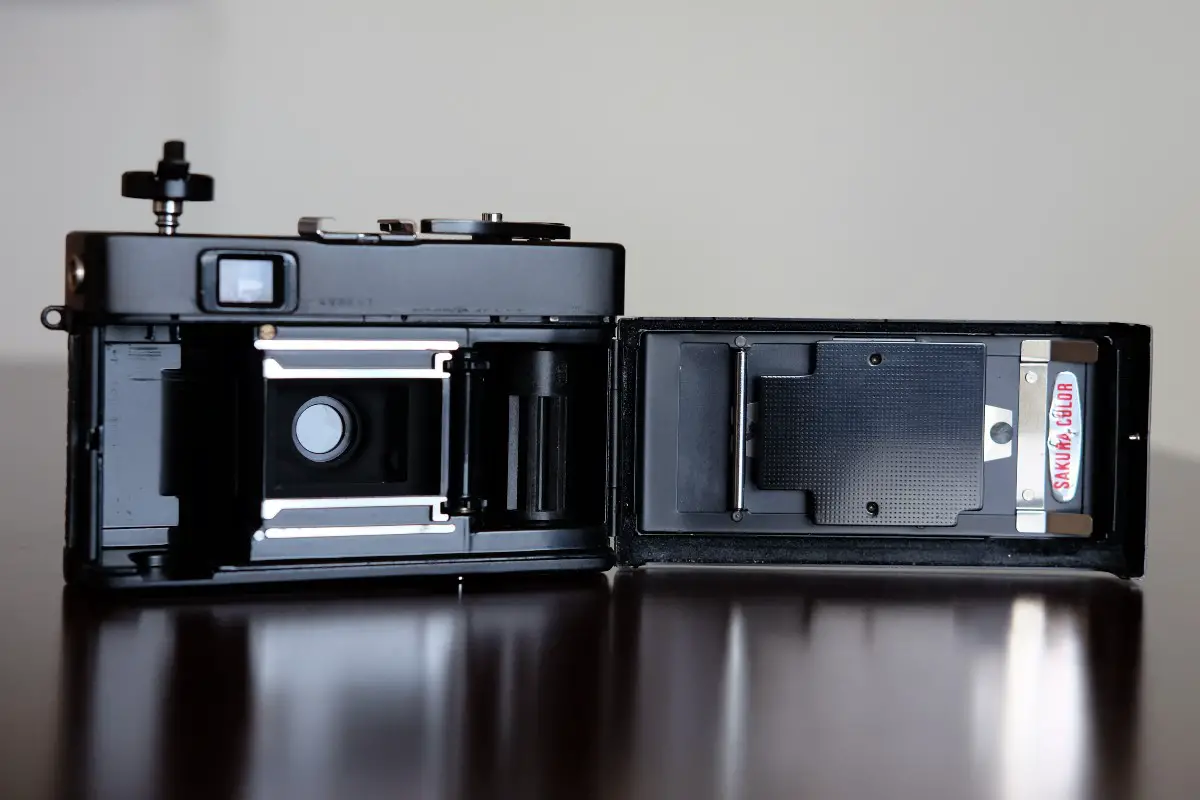
Still, it meant that my expectations were rock bottom when I picked up the developed film the next morning. And so I was pleasantly surprised when I got the film home and ran it through my scanner. Some shots taken, as I recall, when the needle was still in or near the red zone were drastically underexposed and not worth keeping. Others, though, taken in lower light levels were acceptable but needed work.
The ‘before’ image below was scanned, saved as a TIF file and adjusted for perspective in Lightroom, but no other adjustments have been made. The ‘after’ image was subject to some quick, general editing in Lightroom and could undoubtedly be improved further with more time
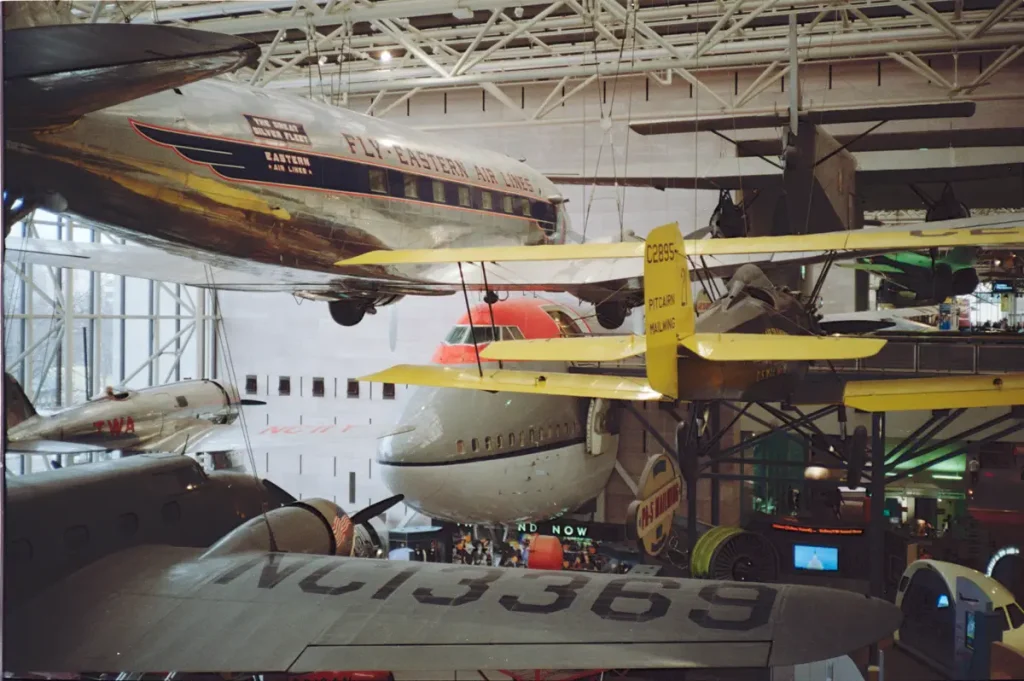
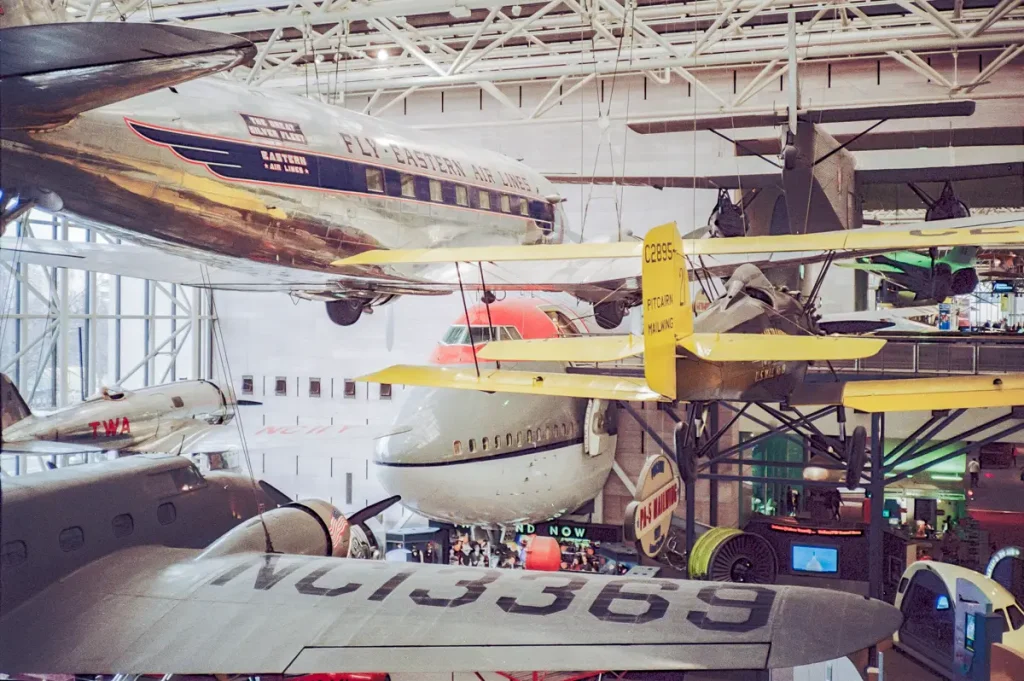
Generally, pictures shot outdoors in good light turned out very well, though there were a couple that weren’t quite up to scratch. This shot showed up some lens flare, something I’m used to being able to see through the lens when using my other cameras, but which I obviously can’t see with the rangefinder. This was the only image affected.

I’d like to tell you what difference it made shooting at ASA100 rather than the box speed of ASA200, but I forgot which ones I shot at the lower rating. (And I’m too new to this to have developed the habit of noting things down. I still get confused when all that information fails to show up in Lightroom.) Suffice it to say that I couldn’t identify images shot at the lower speed from looking at the end results. Given this I’m inclined not to worry too much about the effects of slight difference in battery power on the metering and just set the camera for the box speed.
The rest of the images turned out very nicely, better than I was expecting. These were all scanned as TIF files with a Plustek 8200i SE (which I reviewed recently on Emulsive), and fine tuned in Lightroom.


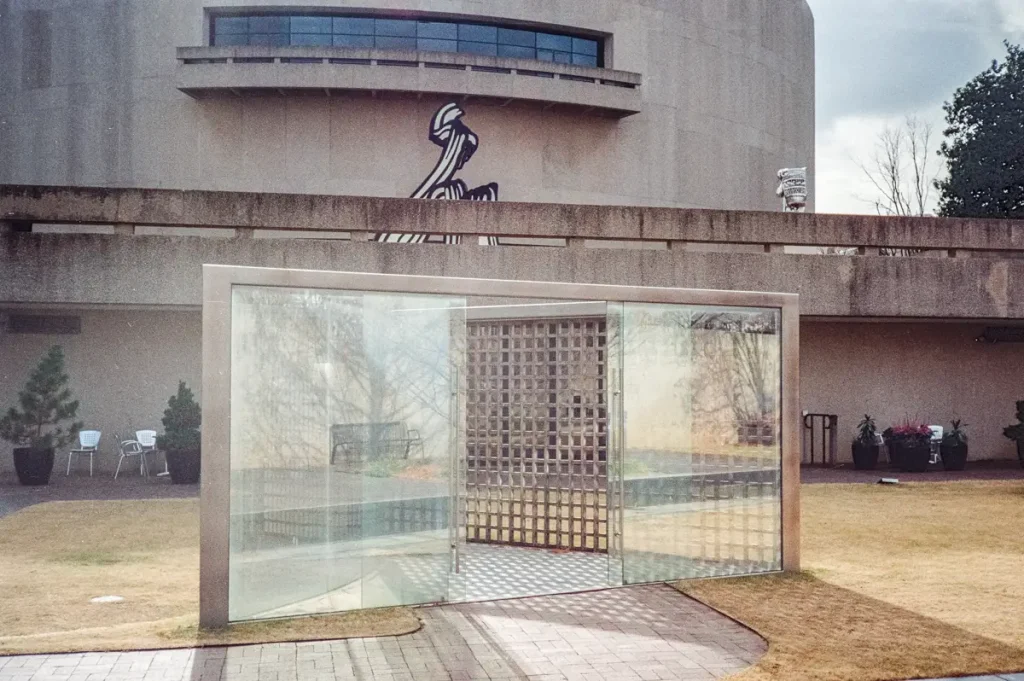






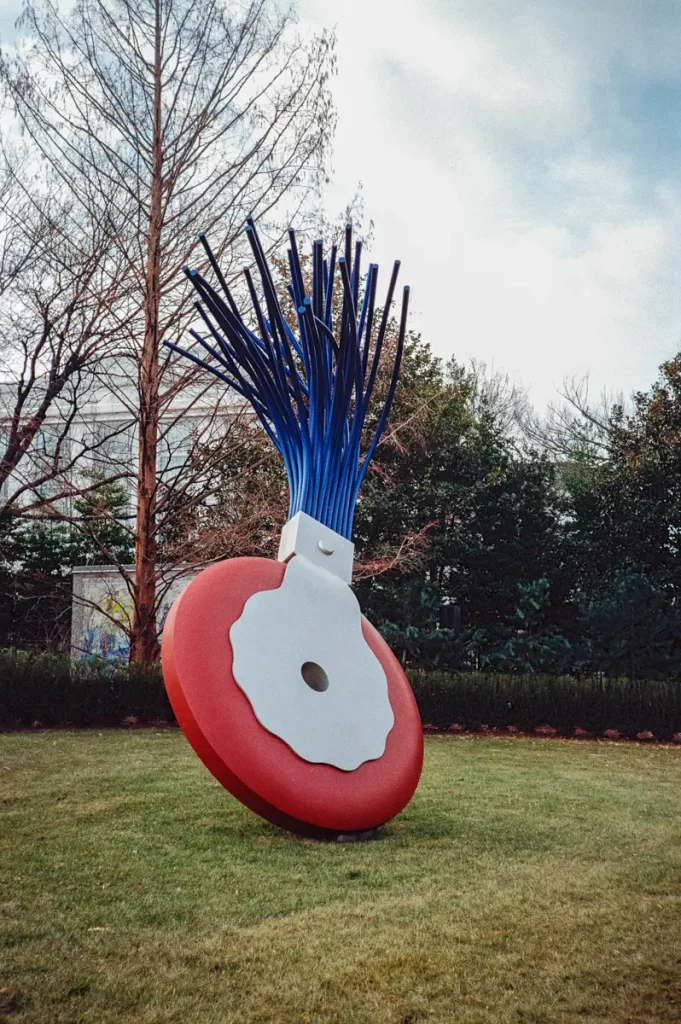


I’ll be keeping the Konica C35. In fact I liked it well enough that when a Konica Auto S3 turned up recently I bought it as well. As it turned out it didn’t work at first either. After fiddling with the battery a little and adjusting the tightness of the battery chamber cover it sprang to life. I then played with the battery in the Konica C35 and discovered that it too can cut out if it is not sitting right in the chamber. So it seems that there was no problem with the actual battery after all.
I’ll need more rangefinder practice but these will be very nice take along camera for times when I’m going to be outdoors in decent light and don’t want to carry anything bigger. Meanwhile 37 Q-Tips and 10 toothpicks later I’ve cleaned up the old light seals. Now I just have to get around to replacing them.
Share this post:
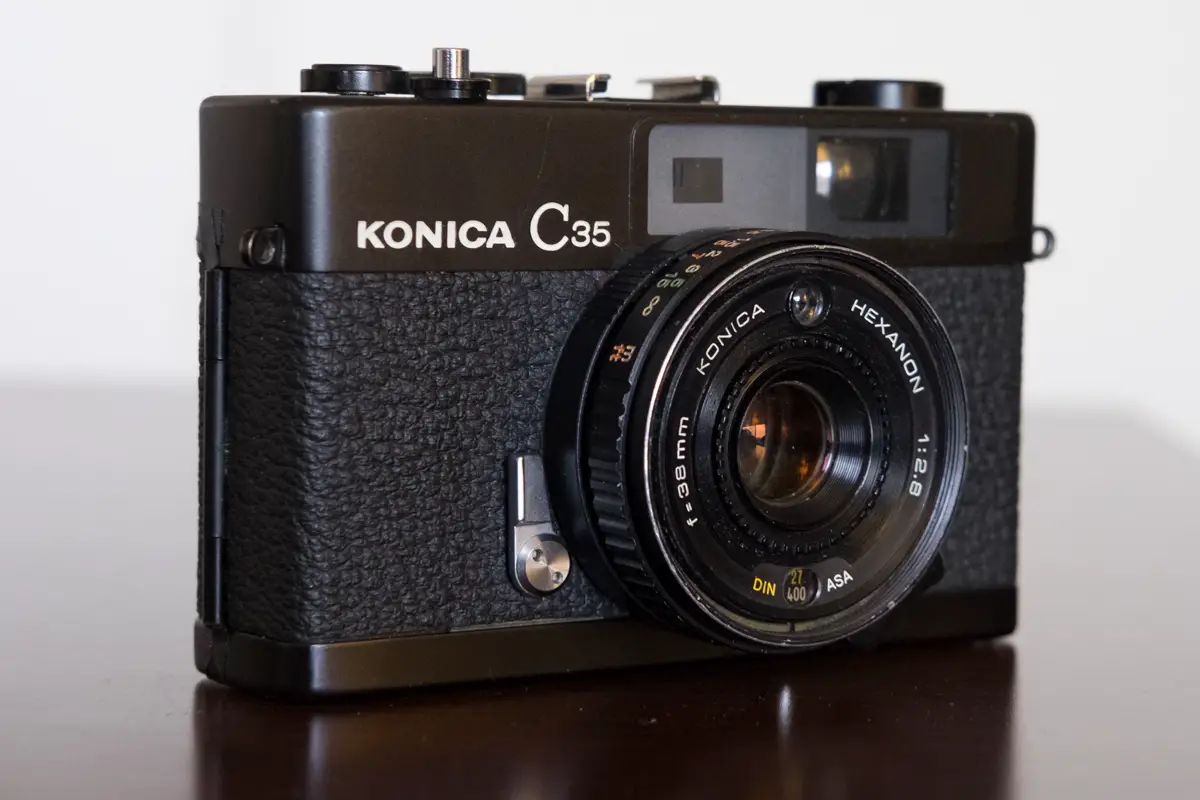








Comments
Dale Willetts on Konica C35 Review – by Olli Thomson
Comment posted: 19/05/2018
Comment posted: 19/05/2018
Leo Tam on Konica C35 Review – by Olli Thomson
Comment posted: 19/05/2018
Comment posted: 19/05/2018
Russ on Konica C35 Review – by Olli Thomson
Comment posted: 19/05/2018
Comment posted: 19/05/2018
Rob MacKillop on Konica C35 Review – by Olli Thomson
Comment posted: 20/05/2018
Comment posted: 20/05/2018
Nigel Cliff on Konica C35 Review – by Olli Thomson
Comment posted: 22/05/2018
Comment posted: 22/05/2018
Peter Boorman on Konica C35 Review – by Olli Thomson
Comment posted: 25/05/2018
Comment posted: 25/05/2018
5 frames with a Konica C35 - by Dale Willetts - 35mmc on Konica C35 Review – by Olli Thomson
Comment posted: 29/06/2018
5 frames with a Konica C35 - by Dale Willetts - 35mmc on Konica C35 Review – by Olli Thomson
Comment posted: 02/07/2018
Angelo on Konica C35 Review – by Olli Thomson
Comment posted: 09/09/2018
Comment posted: 09/09/2018
Comment posted: 09/09/2018
Comment posted: 09/09/2018
John Clarke on Konica C35 Review – by Olli Thomson
Comment posted: 04/12/2018
Thanks for your write up on the C35. It was very helpful.
I just bought one of these, resealed it and put in a new battery. Now I'm going to shoot some film. I'll let you know how it goes.
..... john
Comment posted: 04/12/2018
Redmond Breslin on Konica C35 Review – by Olli Thomson
Comment posted: 01/02/2019
About 2 years ago I bought an Oly 35RC ftom eBay, smaller than the Trip I saved from going to a junk shop. The RC is a little gem but needed a CLA and nee seals but given its excellent condition, worth it. Being a spectacles wearer the small viewfinder can be a problem but otherwise it works really well. I picked up a yellow filter and am waiting to put some Ilford HP5 through it to see how good the photos will turn out. Good luck with the Konica!
Gavin H on Konica C35 Review – by Olli Thomson
Comment posted: 21/02/2019
Jack on Konica C35 Review – by Olli Thomson
Comment posted: 11/03/2019
I just picked one up and have been testing it out, so far the only issue I’m finding is that my meter seems to be working, except for the fact that no matter the scene I’m in, this camera never meters below f/4 even though it should be able to go as wide as f/2.8. I can go into a dark room with barely any light and the camera just won’t go below f/4....
Anyway great review again, thanks!
Konica Auto S3 review - Kosmo Foto on Konica C35 Review – by Olli Thomson
Comment posted: 02/04/2019
Kevin Eyewanders on Konica C35 Review – by Olli Thomson
Comment posted: 08/12/2019
Couple notes: The top cap and gaining access to the viewfinder in these is actually super simple (comparatively) were you to want to freshen it up and clear some fog or dust/dirt bits. Also, flash with these is ridiculously simple, accurate and honestly one of the most fun things about them. The entire shutter range is available for sync and if you use a Konica flash (not sure about others) it won't fire if the camera doesn't think its necessary. Just cool little bitty shooters.
Comment posted: 08/12/2019
Recommended reading : Down the Road on Konica C35 Review – by Olli Thomson
Comment posted: 05/03/2020
First roll: Adox HR-50 - Kosmo Foto on Konica C35 Review – by Olli Thomson
Comment posted: 30/08/2021